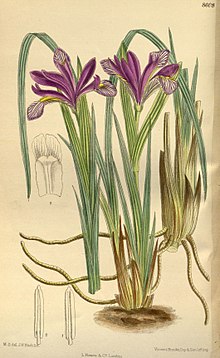Iris sintenisii
| Iris sintenisii | |
|---|---|
 |
|
| An illustration from Curtis Botanical Magazine of Iris urumovii (a synonym of iris sintenisii) | |
| Scientific classification | |
| Kingdom: | Plantae |
| (unranked): | Angiosperms |
| (unranked): | Monocots |
| Order: | Asparagales |
| Family: | Iridaceae |
| Subfamily: | Iridoideae |
| Tribe: | Irideae |
| Genus: | Iris |
| Subgenus: | Limniris |
| Series: | Spuriae |
| Species: | Iris sintenisii |
| Binomial name | |
|
Iris sintenisii Janka |
|
| Synonyms | |
|
|
Iris sintenisii is a species in the genus Iris, it is also in the subgenus of Limniris and in Series Spuriae, with violet-blue flowers.
It is a rhizomatous perennial plant, from regions of Europe, Russia, and Turkey. It is cultivated as an ornamental plant in temperate regions.
Iris sintenisii is intermediate in appearance and form between Iris graminea and a small Iris spuria.
It has thin (or slender), wiry (or hard), short rhizomes. That are covered with the brown, fibrous remains of the last seasons leaves. Over time it forms many branches to create a tight clumps or tussocks.
It has linear, glaucous green to dark green, rigid, acuminate (tapering to a long point), grass-like leaves. They are often described as evergreen. They have clear pronounced veins. They can grow up to between 10–50 cm (4–20 in) long, and 0.3–0.5 cm wide. The leaves often exceed the height of the flower stems.
Iris sintenisii is smaller than Iris graminea. It has cylindrical or slightly compressed, unbranched stems. They can grow up to between 10–40 cm (4–16 in) long.
The stems have 2-3, green spathes, (leaves of the flower bud), that are 3.5-7.5 cm long. The leaves are all keeled. The inner leaves are slightly longer the outer leaves.
The stems or peduncle hold 1 or 2, terminal (top of stem) flowers, between late spring and summer, between June and July.
The flowers are similar in form to Iris graminea but in different shades of colour. The flowers are not scented, and can be up 5–6 cm (2–2 in) in diameter, and come in shades of violet-blue, blue-purple, blue, purple, and violet.
It has 2 pairs of petals, 3 large sepals (outer petals), known as the 'falls' and 3 inner, smaller petals (or tepals, known as the 'standards'. The slender falls are slightly panduriform (shaped like a fiddle). They have a rounded or ovate/elliptic blade, measuring 1.3–1.4 cm long and 0.9–1.3 cm wide. Then they have a narrowing before a long oval haft (connecting to the stem), measuring 2.5–3 cm long and 0.3–0.5 cm wide. The haft is veined with red-purple. They are white or cream, heavily veined violet-blue or purple.
...
Wikipedia
